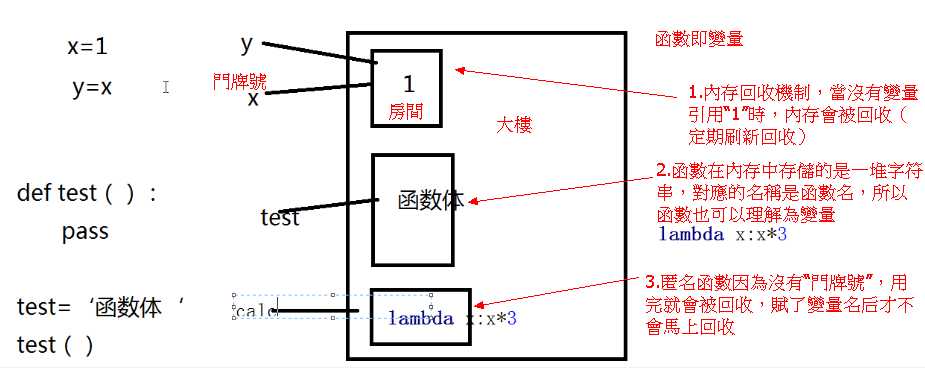标签:规范 背景 rip hello ati isp target stop 执行文件
背景:通过列表生成式能生成一个列表,但受内存限制,列表的容量肯定是有限的。而且当列表元素很多时,会占用大量内存空间,如果只是使用其中的一些元素,那其它元素会造成空间浪费
定义:基于以上原因,如果能通过算法推导出列表的元素,这样就不需要创建完整的list,可以节省空间。这种一边循环一边计算的机制,就叫生成器。
格式:只需把列表生成式[]改成()即可
方法:使用next()可以获取下一个元素,不过一般用for循环打印
函数生成器:在函数中加入yield,函数就变成了一个生成器;而且还可以利用此特性,实现协程的效果
1 #普通列表 2 list_normal = [0,1,2,3,4,5,6,7,8,9,10] #手动生成列表 3 print(list_normal) 4 #列表生成式 5 list_auto = [i for i in range(11)] #利用算法生成列表 6 print(list_auto) 7 8 #生成器 9 list_generator = (i for i in range(11)) #把生成式[]改成()就是生成器了 10 print(list_generator) 11 #生成器方法 12 print(next(list_generator)) 13 print(next(list_generator)) 14 for i in list_generator: 15 print(i)

1 #函数生成器 2 def num_generator(num): 3 i = 0 4 while i <num: 5 #print(i) 6 yield i 7 i +=1 8 return ‘done‘ 9 10 nums = num_generator(5) 11 print(nums) 12 print(nums.__next__()) 13 print(nums.__next__()) 14 print("干点其它事") 15 print(nums.__next__()) 16 print(nums.__next__()) 17 print(nums.__next__()) 18 #函数生成器异常捕获处理 19 while True: 20 try: 21 print("nums:",next(nums)) 22 except StopIteration as e: 23 print("nums gererator return value:",e.value) 24 break

1 #单线程实现并发运算 2 import time,os 3 4 def command(): 5 print("开始ping啦") 6 while True: 7 addr = yield 8 os.system("ping "+‘ ‘+ addr) 9 10 def ips(): 11 t = command() 12 t.__next__() 13 print("开始分配IP地址") 14 for i in range(2): 15 if i == 0: 16 continue 17 else: 18 address = "10.172.116.%s"%i 19 time.sleep(1) 20 t.send(address) 21 ips()
可迭代对象Iterable:
可以被for循环的数据类型,包含二类:
1.集合数据类型:list、dict、tuple、set、str等
2.generator,包含生成器、带yield的generator function
1 from collections import Iterable 2 from collections import Iterator 3 4 #判断是否是可迭代对象 5 isinstance([],Iterable) 6 isinstance({},Iterable) 7 isinstance((),Iterable) 8 isinstance(‘string‘,Iterable) 9 isinstance(100,Iterable) #数字不可迭代
迭代器Iterator:
定义:可以被next()函数调用并不断返回下一个值的对象称为迭代器
特性:
把Iterable变成Iterator可以使用Iter()函数
生成器都是Iterator对象,但list、tuple、dict等虽是Iterable,却不是Iterator
1 #判断是否是迭代器 2 isinstance([],Iterator) 3 isinstance({},Iterator) 4 isinstance((),Iterator) 5 isinstance(‘string‘,Iterator) 6 isinstance(100,Iterator) 7 isinstance((x for x in range(10)),Iterator) 8 9 #迭代对象转换成迭代器方法 10 Iter_list = iter([1,2,3]) 11 print(iter_list)
区别:
Iterator对象表示的是一个数据流,可以被next()函数调用并不断返回下一个数据,直到数据抛出StopIteration错误。可以把Iterator看成是一个有序序列,但我们却不能提前知道序列长度,它可以表示一个无限大的数据流,如自然数,而这是list办不到的。
for循环本质上是通过不断调用next()实现的

1 #for循环 2 for i in [1,2,3]: 3 print(i) 4 5 #等同于下面的迭代器 6 a = iter([1,2,3]) 7 while True: 8 try: 9 next(a) 10 except StopIteration: 11 break
python装饰器:http://blog.51cto.com/egon09/1836763
定义:本质是函数,功能是装饰其它函数,就是为其它函数添加附加功能
原则:1.不能修改被装饰的函数的源代码(对被装饰函数是透明的)
2.不能修改被装饰的函数的调用方式
实现装饰器知识储备:(高阶函数+嵌套函数=装饰器)
1.函数即“变量”

2.高阶函数
a.把一个函数名当做实参传给另一个函数(在不修改被装饰函数源代码的情况下为其添加功能)
b.返回值中包含函数名(不修改函数的调用方式)

1 #高阶函数 2 def bar(): 3 time.sleep(3) 4 print(‘in the bar‘) 5 6 def test2(func): 7 print(func) 8 return func 9 10 t = test2(bar) 11 t() #run bar 12 13 bar=test2(bar) #把之前函数bar名称覆盖了 14 bar()
3.嵌套函数
定义:一个函数体内用def去声明一个新的函数

1 #嵌套函数 2 def foo(): 3 print(‘in the foo‘) 4 def bar(): 5 print(‘in the bar‘) 6 bar() 7 foo()

1 #局部作用域和全局作用域的访问顺序 2 x=0 3 def grandpa(): 4 x=1 5 def dad(): 6 x=2 7 def son(): 8 x=3 9 print(x) 10 son() 11 dad() 12 grandpa() #结果是3,从最里面找变量
4.装饰器案例

1 #装饰器案例1 2 #运行test1-->等同于运行deco-->运行deco过程中会运行原来的test1函数-->并附加了计时功能 3 def timer(func): #嵌套函数 timer(test1) func=test1 4 def deco(): #高阶函数 5 start_time = time.time() 6 func() #run test1 7 stop_time = time.time() 8 print("run time :%s"%(stop_time-start_time)) 9 return deco #返回deco的内存地址 10 11 @timer #等同于test1 = timer(test1) 12 def test1(): 13 time.sleep(3) 14 print(‘in the test1‘) 15 16 test1() #run deco

1 1 #装饰器案例2 2 2 #实现不定量传参,装饰器更有扩展性 3 3 def timer(func): #嵌套函数 timer(test1) func=test1 4 4 def deco(*arg,**kwargs): #高阶函数 5 5 start_time = time.time() 6 6 func(*arg,**kwargs) #run test1 7 7 stop_time = time.time() 8 8 print("run time :%s"%(stop_time-start_time)) 9 9 return deco #返回deco的内存地址 10 10 11 11 @timer #等同于test1 = timer(test1) 12 12 def test1(): 13 13 time.sleep(3) 14 14 print(‘in the test1‘) 15 15 16 16 @timer #等同于test2 = timer(test2)=deco test2(name)=deco(name) 17 17 def test2(name): 18 18 print(‘test2:‘,name) 19 19 20 20 test1() #run deco 21 21 test2(‘sam‘)

1 #网站认证装饰器-初版 2 #需求:登录index页面不需要认证,登录home/bbs要认证(使用装饰器) 3 user,passwd = ‘sam‘,‘123‘ 4 def auth(func): #装饰器 5 def wrapper(): 6 username = input("Username:").strip() 7 password = input("Password:").strip() 8 if username == user and password == passwd: 9 print("登录成功!") 10 func() 11 else: 12 print("用户名或密码错误.") 13 return wrapper 14 15 def index(): #不认证 16 print("Welcome to the index page.") 17 18 @auth 19 def home(): #装饰器认证 20 print("Welcome to the home page.") 21 22 @auth 23 def bbs(): #装饰器认证 24 print("Welcome to the bbs page.") 25 26 home() 27 bbs()

1 #网站认证装饰器-进阶版 2 #需求:登录index页面不需要认证,登录home/bbs要使用认证方式(使用装饰器),home传参数且有返回值 3 user,passwd = ‘sam‘,‘123‘ 4 def auth(func): 5 def wrapper(*args,**kwargs): 6 username = input("Username:").strip() 7 password = input("Password:").strip() 8 if username == user and password == passwd: 9 print("登录成功!") 10 res = func(*args,**kwargs) 11 #print("---认证之后---") 12 return res 13 else: 14 print("用户名或密码错误.") 15 return wrapper 16 17 def index(): 18 print("Welcome to the index page.") 19 20 @auth 21 def home(*args): 22 print("Welcome to the home page.",args) 23 return "From home page" 24 25 @auth 26 def bbs(): 27 print("Welcome to the bbs page.") 28 29 #home() 30 print(home(‘sam‘))

1 #网站认证装饰器-终极版 2 #需求:登录index页面不需要认证,登录home/bbs要使用不同的认证方式local/ldap(使用装饰器),home传参数且有返回值 3 user,passwd = ‘sam‘,‘123‘ 4 def auth(auth_type): 5 #print("auth func:",auth_type) 6 def outer_wrapper(func): 7 def wrapper(*args,**kwargs): 8 #print("wrapper func args:", *args, **kwargs) 9 if auth_type == ‘local‘: 10 username = input("Username:").strip() 11 password = input("Password:").strip() 12 if username == user and password == passwd: 13 print("登录成功!") 14 res = func(*args,**kwargs) 15 #print("---认证之后---") 16 return res 17 else: 18 print("用户名或密码错误.") 19 elif auth_type == ‘ldap‘: 20 print("使用Ldap认证") 21 return wrapper 22 return outer_wrapper 23 24 def index(): 25 print("Welcome to the index page.") 26 27 @auth(auth_type=‘local‘) #home=auth 28 def home(*args): 29 print("Welcome to the home page.",args) 30 return "From home page" 31 32 @auth(auth_type=‘ldap‘) 33 def bbs(): 34 print("Welcome to the bbs page.") 35 36 home() 37 bbs()
xml逐渐被json取代
Json不支持函数序列化,只能处理简单的数据类型

#序列化 import json def sayhi(name): print("hello,",name) info = { ‘name‘:‘alex‘, ‘age‘:22, #‘func‘:sayhi #不能序列化函数 } f = open("test.text","w") f.write( json.dumps( info) ) info[‘age‘] = 21 f.write( json.dumps( info) ) f.close() #反序列化 import json f = open("test.text","r") #data = json.loads(f.read()) #data = pickle.loads(f.read()) for line in f: print(json.loads(line))
Json是不同开发语言都支持的交互方式,pickle是python自有的
pickle可以序列化所有数据类型,但函数不能序列

1 #序列化 2 import pickle 3 4 def sayhi(name): 5 print("hello,",name) 6 7 info = { 8 ‘name‘:‘alex‘, 9 ‘age‘:22, 10 ‘func‘:sayhi 11 } 12 13 14 f = open("test.text","wb") 15 16 pickle.dump(info,f) #和f.write( pickle.dumps( info) )功能一样 17 18 f.close() 19 20 #反序列化 21 def sayhi(name): 22 print("hello2,",name) 23 24 f = open("test.text","rb") 25 26 data = pickle.load(f) #和data = pickle.loads(f.read())功能一样 27 28 print(data["func"]("Alex"))
注:dump一次load一次,不要dump多次
bin-执行文件
site-packages--模组
main-主程序
docs-说明文档
Day4 - Python基础4 迭代器、装饰器、软件开发规范
标签:规范 背景 rip hello ati isp target stop 执行文件
原文地址:https://www.cnblogs.com/pynetwork/p/8980509.html